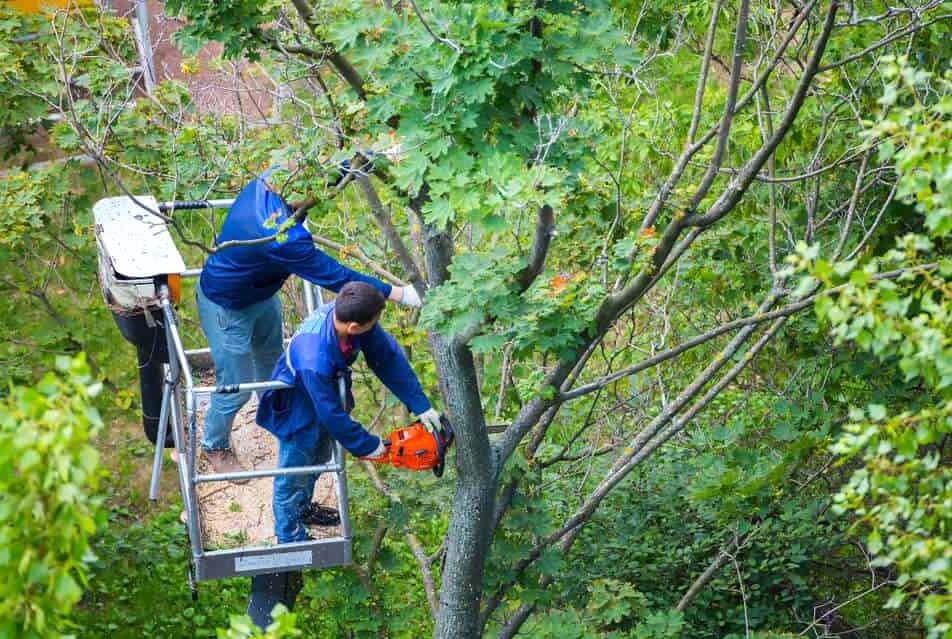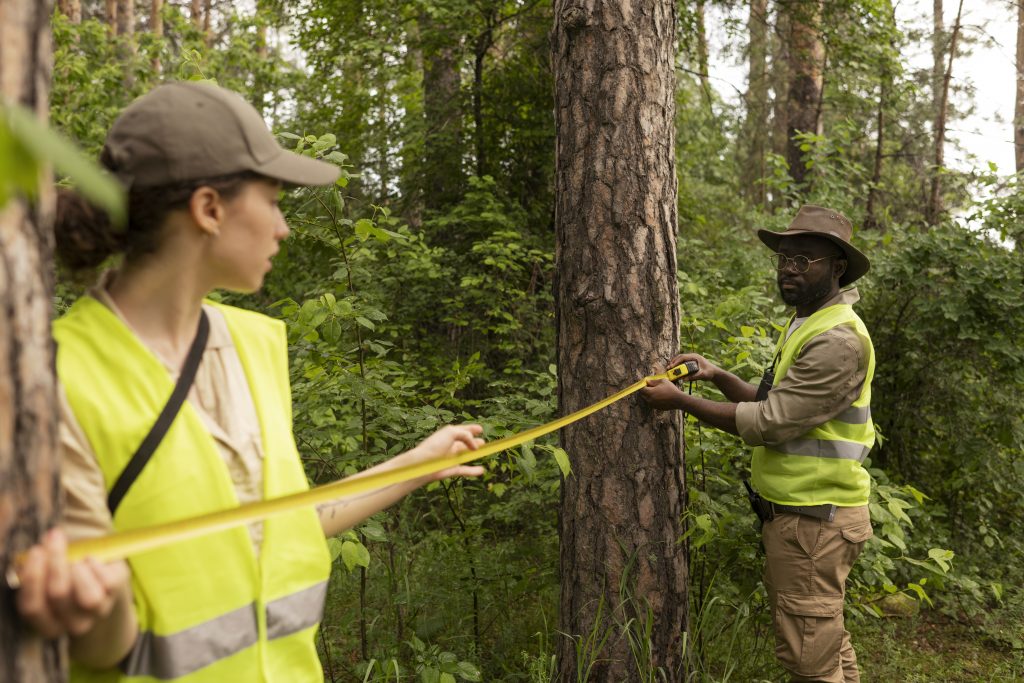The Importance of Properly Pruning Trees for Structural Integrity
THE IMPORTANCE OF PROPERLY PRUNING TREES FOR STRUCTURAL INTEGRITY
Tree pruning is a horticultural practice that involves selectively removing specific branches or parts of a tree to improve its health, aesthetics, structure, and safety. Pruning is a crucial aspect of tree care and plays a significant role in maintaining the overall well-being of trees. Here’s an explanation of tree pruning and its significance:

-
Structural Enhancement:
- Pruning helps shape a tree’s growth by directing its development. By removing branches that grow irregularly, cross each other, or have weak attachments, pruning helps create a stronger and more stable tree structure. This reduces the risk of branches breaking and falling, which can cause accidents or property damage.
-
Health and Vigor:
- Pruning promotes the overall health and vigor of trees. By removing dead, diseased, or damaged branches, pruning prevents the spread of diseases and infestations. It also encourages the growth of new, healthy branches and leaves, enhancing the tree’s ability to photosynthesize and thrive.
-
Safety Enhancement:
- Safety is a critical aspect of tree care. Proper pruning reduces the risk of falling branches, which can pose dangers to people, pets, and property. Regular pruning ensures that trees are structurally sound and less likely to fail during storms or adverse weather conditions.
-
Aesthetic Improvement:
- Pruning is often used to enhance the aesthetic appeal of trees. Trimming overgrown or unsightly branches can improve the tree’s shape, symmetry, and overall appearance. Well-pruned trees can enhance the visual appeal of landscapes, gardens, and urban environments.
-
Encouraging Fruit Production:
- Fruit trees benefit from pruning to optimize fruit production. Thinning branches and removing excess growth allows more sunlight and air circulation, resulting in larger and higher-quality fruit yields.
-
Disease and Pest Control:
- Pruning can help control and prevent the spread of diseases and infestations. By removing affected branches, infected areas can be isolated and treated, reducing the impact on the entire tree.
-
Clearing Obstructions:
- Pruning is used to clear branches that obstruct structures, utility lines, roads, sidewalks, or visibility for drivers and pedestrians. This is essential for safety and infrastructure maintenance.
-
Promoting New Growth:
- Pruning stimulates the growth of new branches and foliage, rejuvenating older trees and encouraging new growth in younger ones. This is particularly useful for maintaining tree health and vitality.
-
Fire Safety:
- In fire-prone areas, pruning helps reduce the risk of wildfires spreading by removing low-hanging branches and deadwood that can act as fuel. This creates defensible spaces around homes and communities.
-
Professional Tree Care:
– Proper tree pruning requires knowledge and expertise. Certified arborists are trained to assess trees, determine the appropriate pruning techniques, and carry out the work safely and effectively. Hiring professionals ensures that pruning is done correctly and maximizes the benefits while minimizing risks.
In conclusion, tree pruning is a vital component of tree care that promotes tree health, safety, aesthetics, and overall well-being. When performed correctly and with consideration for the specific needs of each tree, pruning contributes to the longevity and vitality of trees while reducing potential hazards to people and property.
How regular pruning helps identify and address potential hazards?

Regular pruning plays a critical role in identifying and addressing potential hazards associated with trees. By systematically evaluating a tree’s condition and selectively removing problematic branches or growth, arborists and property owners can reduce the risk of accidents, property damage, and other safety concerns. Here’s how regular pruning helps identify and address potential hazards:
-
Branch Assessment:
- During regular pruning, arborists or tree care professionals assess the condition of a tree’s branches. They look for signs of weakness, disease, decay, or damage, such as cracks, splits, deadwood, or disease-related cankers.
-
Dead Branch Removal:
- One of the primary hazards in trees is deadwood. Dead branches can break and fall unpredictably, posing a danger to people, pets, vehicles, and structures below. Pruning removes these dead branches, reducing the risk of accidents and property damage.
-
Diseased and Infested Branch Removal:
- Trees with diseases or infestations often have weakened branches. Pruning removes affected branches, preventing the spread of diseases and pests to other parts of the tree and neighboring trees.
-
Reducing Weight and Leverage:
- Overgrown branches with excessive foliage can create heavy canopies. When these branches extend too far from the main trunk, they can exert significant leverage and become prone to breakage, especially during storms. Pruning reduces the weight and leverage of branches, making them less likely to fail.
-
Correcting Poor Growth Patterns:
- Trees with poor growth patterns, such as co-dominant stems or branches with tight crotches, are more likely to develop structural weaknesses. Pruning can correct these issues by selectively removing or reducing problematic branches.
-
Preventing Overcrowding:
- When branches are densely packed, they may rub against each other, causing wounds and creating entry points for diseases and pests. Pruning opens up the canopy, improving air circulation and reducing the risk of branch damage and infection.
-
Hazardous Limb Reduction:
- Limbs that extend over roofs, walkways, roads, or utility lines can be hazardous. Pruning can be used to reduce the length and weight of such limbs or remove them entirely to prevent accidents and damage.
-
Storm Resistance:
- Well-pruned trees are more wind-resistant and can better withstand the forces of storms. Pruning reduces the “sail effect” of a tree’s canopy, decreasing the risk of branches breaking or the entire tree toppling during high winds.
-
Property and Infrastructure Protection:
- Pruning helps maintain safe distances between trees and nearby structures, including buildings, power lines, and roads. By preventing branches from encroaching on these areas, the risk of property damage and power outages is reduced.
- Regular Monitoring: – Regular pruning includes ongoing monitoring of the tree’s health and structure. This allows for the early detection of emerging hazards, enabling timely intervention and risk reduction.
In summary, regular pruning is a proactive approach to tree care that helps identify and address potential hazards before they become imminent threats. By systematically assessing tree health and structure and applying appropriate pruning techniques, property owners and arborists can ensure that trees remain safe, healthy, and less likely to pose risks to people and property.
Emphasize that hazard mitigation is a critical component of safety.
Hazard mitigation is an absolutely critical component of safety when it comes to tree care and maintenance. Here are key reasons why hazard mitigation plays a pivotal role in ensuring the safety of individuals, property, and the surrounding environment:
- Prevention of Accidents: Hazard mitigation through proper tree pruning and maintenance aims to prevent accidents caused by falling branches, limbs, or entire trees. Accidents involving falling trees or branches can result in serious injuries or even fatalities. By identifying and addressing potential hazards early, these accidents can be avoided.
- Property Protection: Hazardous trees pose a significant risk to property, including homes, vehicles, fences, and other structures. Falling branches or trees can cause extensive damage and financial loss. Hazard mitigation measures, such as regular pruning, help protect property from the destructive forces of falling debris.
- Utility Infrastructure Safety: Trees growing near utility lines can disrupt services, cause power outages, and create fire hazards. Hazard mitigation in the form of pruning or tree removal ensures that utility lines remain safe and functional, reducing the risk of electrical fires and service interruptions.
- Road Safety: Trees near roads and highways can become hazards if branches obstruct visibility, or if falling trees or limbs block roadways. Hazard mitigation efforts prevent road accidents, ensure clear sightlines for drivers, and reduce the risk of road closures due to tree-related incidents.
- Public Safety: In urban and suburban areas, trees are often situated near public spaces, walkways, and recreational areas. Hazard mitigation helps create safer environments for pedestrians, cyclists, and park visitors by minimizing the risk of falling branches.
- Storm Preparedness: Hazard mitigation through proper pruning and tree care enhances a tree’s ability to withstand the forces of storms and severe weather. Well-maintained trees are less likely to fail during storms, reducing the risk of damage to structures and vehicles.
- Fire Prevention: In fire-prone regions, hazardous trees can fuel wildfires and contribute to their rapid spread. Mitigating these hazards by pruning and removing combustible vegetation helps protect communities from the devastating effects of wildfires.
- Environmental Stewardship: Proper hazard mitigation practices prioritize the health and longevity of trees while reducing potential risks. This approach aligns with the principles of environmental stewardship, ensuring that trees continue to benefit ecosystems and communities.
- Legal and Liability Considerations: Property owners and municipalities may have legal obligations to maintain safe conditions on their properties. Neglecting hazardous trees can lead to legal liabilities if accidents occur.
In summary, hazard mitigation is not just a safety measure; it is a moral and legal responsibility. It recognizes that trees, while valuable and essential, can become hazardous over time due to factors like disease, decay, or storm damage. By proactively identifying and addressing these hazards through pruning, tree care professionals and property owners contribute to a safer environment for everyone while preserving the many benefits that trees provide.
About Murray, Utah
Murray is a city situated on the Wasatch Front in the core of Salt Lake Valley in the U.S. state of Utah. Named for territorial governor Eli Murray, it is the state's fourteenth largest city. According to the 2020 census, Murray had a population of 50,637. Murray shares borders with Taylorsville, Holladay, South Salt Lake and West Jordan, Utah. Once teeming with heavy industry, Murray's industrial sector now has little trace and has been replaced by major mercantile sectors. Known for its central location in Salt Lake County, Murray has been called the Hub of Salt Lake County. Unlike most of its neighboring communities, Murray operates its own police, fire, power, water, library, and parks and recreation departments and has its own school district. While maintaining many of its own services, Murray has one of the lowest city tax rates in the state.
Neighborhoods in Murray, Utah
Murray Oakes, Grant Park, Southwood Park, Murray Park, Murray Park Restrooms, Willow Pond Park, Neighborhood Veterinary Care
Things To Do in Murray, Utah
Bus Stops in Murray, Utah to Truco Services, Inc.
Bus Stop in Murray Central Station (Bay C) Murray, Utah to Truco Services, Inc.
Bus Stop in State St @ 4801 S Murray, Utah to Truco Services, Inc.
Bus Stop in Murray North Station Murray, Utah to Truco Services, Inc.
Bus Stop in State St @ 4949 S Murray, Utah to Truco Services, Inc.
Bus Stop in Murray Central Frontrunner/Trax Station Murray, Utah to Truco Services, Inc.
Bus Stop in Murray Blvd / Vine St (SB) Murray, Utah to Truco Services, Inc.
Bus Stop in State St @ 3925 S Murray, Utah to Truco Services, Inc.
Bus Stop in State St @ 4824 S Murray, Utah to Truco Services, Inc.
Bus Stop in State St @ 5223 S Murray, Utah to Truco Services, Inc.
Bus Stop in Murray Blvd / Allendale Dr (NB) Murray, Utah to Truco Services, Inc.
Bus Stop in Murray Blvd @ 5039 S Murray, Utah to Truco Services, Inc.
Bus Stop in State St @ 4721 S Murray, Utah to Truco Services, Inc.
Driving Directions in Murray, Utah to Truco Services, Inc.
Driving Directions from Woodruff Tree Trimming and Removal to 4640 Commerce Dr, Murray, UT 84107, USA
Driving Directions from Reliable Tree Care to 4640 Commerce Dr, Murray, UT 84107, USA
Driving Directions from Tree Pro-Tech to 4640 Commerce Dr, Murray, UT 84107, USA
Driving Directions from Prestige Tree And Landscape to 4640 Commerce Dr, Murray, UT 84107, USA
Driving Directions from Excellence Tree & Landscape to 4640 Commerce Dr, Murray, UT 84107, USA
Driving Directions from Amen Trees to 4640 Commerce Dr, Murray, UT 84107, USA
Driving Directions from Tim's Tree Care to 4640 Commerce Dr, Murray, UT 84107, USA
Driving Directions from Jordan Tree Service - Murray to 4640 Commerce Dr, Murray, UT 84107, USA
Driving Directions from Arbor Works to 4640 Commerce Dr, Murray, UT 84107, USA
Driving Directions from Diamond Tree Experts to 4640 Commerce Dr, Murray, UT 84107, USA
Driving Directions from Green Tree Arborist to 4640 Commerce Dr, Murray, UT 84107, USA
Driving Directions from TruCo Services to 4640 Commerce Dr, Murray, UT 84107, USA
Reviews for Truco Services, Inc. Murray, Utah
Emily Abercrombie
We had a great experience with TruCo! They were well priced, responsive and prompt. Michael was a pleasure to work with and gave us advice on which plants to put in where we took out our ugly old shrubs. I would highly recommend this company!!!
Michelle Turpin
TruCo Services gets 5 stars from us for customer service. We experienced a few issues with their services this last year and Rob Eccles in senior management, stepped in and immediately handled our issues. He was very committed to making sure they understood our expectations and would execute to make us happy.
Siobhan Billingsley
I work for a property management company and have the pleasure of working with Rob at a community in Sandy. He has been incredible to work with and always responds in a timely manner. He knows all the homeowners by name and address and is aware of all the "problem" areas when it comes to sprinklers. I never have to worry about following up with him because he always reaches out to provide me with an update. If you're looking to work with someone who takes pride in their job, is professional, and can solve the worst landscaping problems thrown your way, Rob is your guy. Thank you, Rob for all you do!
Jaime S.
We have used Truco at 2 of the complexes we manage, they have been great to work with. Good quality service, outstanding customer service with good communication. That's hard to find these days. I highly recommend them. Travis has been awesome to work with.
Jerusha Smart
We use TruCo for a majority of our properties and our home. While other landscaping companies we use come and go for various reasons like cost, communication issues, work performance, etc., TruCo is always consistent in price and work. Also, Rob is the best.
